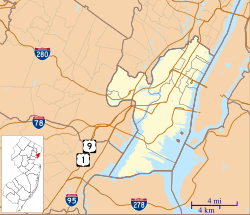Hoboken (NJT station)
|
Hoboken Terminal
|
|
|---|---|

The renovated waiting room in 2004.
|
|
| Location | 1 Hudson Place Hoboken, NJ |
| Owned by |
Street level: NJ Transit Underground: PANYNJ |
| Line(s) |
NJ Transit commuter rail: Metro-North Railroad Hudson – Bergen Light Rail: PATH: |
| Platforms | 9 island platforms and 1 side platform |
| Tracks | 18 |
| Connections |
|
| Construction | |
| Platform levels | 2 |
| Parking | available within area |
| Bicycle facilities | 88 spaces |
| Disabled access | Yes |
| Other information | |
| Station code | HOB |
| Fare zone | 1 |
| History | |
| Opened | February 25, 1907 |
| Electrified | 1930: 25 kV 60 Hz (NJT) 600 V (DC) third rail (PATH) 750 V DC Overhead lines (Light rail) |
| Traffic | |
| Passengers (2012) | 16,297 (average weekday) (NJT) |
| Passengers (2015) | 8,238,955 |
| Services | |
|
Erie-Lackawanna Railroad Terminal at Hoboken
|
|
| Location | On the Hudson River at the foot of Hudson Place, Hoboken, New Jersey |
| Coordinates | 40°44′5.64″N 74°1′40.08″W / 40.7349000°N 74.0278000°WCoordinates: 40°44′5.64″N 74°1′40.08″W / 40.7349000°N 74.0278000°W |
| Area | 4 acres (2 ha) |
| Built | 1907 |
| Architect | Kenneth MacKenzie Murchison |
| Architectural style | American Industrial |
| NRHP Reference # | 73001102 |
| Added to NRHP | July 24, 1973 |
|
|
|
|
|
|
|
|
|
|
|
|
|
|
|
|
|
NJ Transit commuter rail:
Metro-North Railroad
Hudson – Bergen Light Rail:
PATH:
Hoboken Terminal is one of the New York metropolitan area's major transportation hubs. The commuter-oriented intermodal facility is in Hoboken, Hudson County, New Jersey, United States. It is served by nine NJ Transit (NJT) commuter rail lines, one Metro-North Railroad line, various NJT buses and private bus lines, the Hudson–Bergen Light Rail, the Port Authority Trans Hudson (PATH) rapid transit system, and NY Waterway-operated ferries. More than 50,000 people use the terminal daily, making it New Jersey's second-busiest railroad station and its third-busiest transportation facility, after Newark Liberty International Airport and Newark's Penn station. Hoboken Terminal is wheelchair accessible, with high-level platforms for light rail and PATH services and portable lifts for commuter rail services.
The site of the terminal has been used since colonial times to link Manhattan Island and points west. It was long a ferry landing accessible via turnpike roads, and later plank roads (namely the Hackensack, the Paterson and a spur of the Newark Plank Road). In 1811, the first steam-powered ferries began service under John Stevens, an inventor who founded Hoboken.
...
Wikipedia



